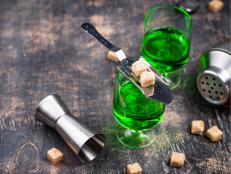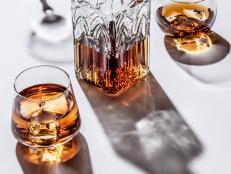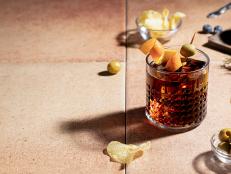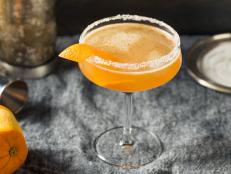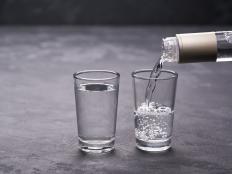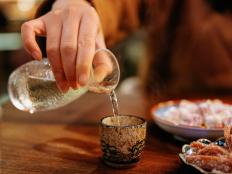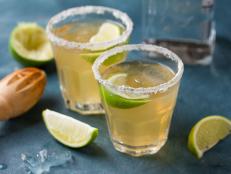Champagne vs Sparkling Wine: What's the Difference?
Plus which types of sparkling wines taste like Champagne--at a fraction of the price.

Oscar Wong/Getty Images
By Dana Beninati for Food Network Kitchen
Dana is a host, chef and sommelier.
Champagne is sparkling wine, but not every sparkling wine is a Champagne. If a sparkling wine is made outside of a specific French region, appropriately named Champagne, then it cannot be called Champagne. This remains true even if the wine is made in France, which is responsible for 20% of sparkling wine production worldwide. While a bottle of bubbly remains an essential component of any celebration, its country of origin may not matter to you. Read on to learn what distinguishes every type of sparkling wine.

bhofack2/Getty Images
Champagne vs Sparkling Wine: What's the Difference?
The difference between Champagne and all other sparkling wines comes down to where the wine is made - Champagne must be produced in Champagne, France using an ancient method know as Methode Champenoise.
Region
As we've discussed, Champagne can only come from the region of France bearing the same name. Since World War I, the Champagne region has been declared an AOC, or a protected are of wine production. In fact, there was a clause written into the Treaty of Versailles to ensure that this area would be protected from German rule. However, America never signed this treaty, creating a sneaky loophole for California wineries that produced sparkling wine in the 1900’s. In that vein, sparkling wines can come from anywhere.
Production Method
The process of producing champagne, known as Methode Champenoise, is unique and involved. This method pushes grape juice through two rounds of fermentation (most wines only ferment once) and then ages the wine with the yeast that died during said fermentation in the bottle. These dead yeast cells are what give Champagne it’s complex and iconic flavor, best described as toasted bread with soft butter or caramelized nuts.
Methode Champenoise is used outside of the region to make sparkling wines of comparable quality, that go by other names such as Cava.
There are also several alternative methods to make sparkling wines, many of which are considered shortcuts that produce wines of lower price point and quality. Every country that produces sparkling wine today has its own unique set of rules about how it is made: from harvesting, to pressing, and requirements for aging. We will explore them all below.
Grapes
Champagne is typically made from three grapes: Chardonnay, Pinot Noir and Pinot Meunier. In addition, four other grape varietals are permitted for use in Champagne – Arbane, Pinot Blanc, Pinot Gris and Petit Meslier.
Outside the region of Champagne, winemakers make sparkling wine from a variety of grapes that grow well in their respective regions.
Price Tag
Because Methode Champenoise is very time consuming, Champagne generally has a higher price tag than other sparkling wines.

LightFieldStudios/Getty Images
What Is Sparkling Wine? And Common Types of Sparkling Wine
Sparkling wine is, in short, fizzy wine made from any type of grape and produced anywhere in the world. It's a pretty broad category, so below, we break down the details of a few main types.
American Champagne
Many winemakers in America and across the New World create sparkling wines using the traditional method. Remember that Treaty of Versailles back in 1941? Well, it was revisited in 1983, when the French made additional efforts to protect the brand of Champagne. After years of negotiations, it was finally decided that America could create “Champagne California” until 2006. Now, this term is outdated and all bottle of bubbly hailing from the states are considered sparkling.
Cremant
The term is used to describe sparkling wines made within the country of France, but outside the region of Champagne. You will notice that these wines are generally less effervescent than most other sparkling wines, but no less delicious.
Cava
The sparkling wine of Spain, Cava means “cave” which speaks to the fact that these wines are aged in underground caves that protect the wine from sunlight and temperature spikes. Cava is used to describe all sparkling wine from Spain, but typically comes from the Penedes region. Look for the term “Corpinnat” on the label to taste a Cava that is made to directly compete with the complexity of Champagne, putting long aging periods and biodynamic farming practices to work.
Franciacorta
Most think Prosecco to be the Italian sparkling wine, but Franciacorta is Italy’s answer to Champagne. Made in the Franciacorta region of central Italy, this wine is hand-harvested and aged in the bottle, just like Champagne. Harder to find but worth the search, Franciacorta is available in white, rose and red styles. Some can match the complexity and price tag of quality Champagne.
Pet-Nat
This is the French term for a natural sparkling wine, made with little to no manipulation from the farmer and winemaker. You may know that carbon dioxide is a biproduct of fermentation. Pet-Nat’s are made from just one round of fermentation that occurs directly in the bottle, thereby trapping carbon dioxide and creating a simple sparkling wine. These wines taste pleasantly funky and give you more to think about than you average grocery store sparkling wine.
Piquette
French for “prickle” this is a low-alcohol wine made from the leftovers of winemaking (grape stems, skins and seeds). It was originally created to quench the thirst of farm workers but is now found in trendy wine shops across France and the US. This style of wine is usually a blend of many different grape varietals, so the flavor is pleasantly unpredictable.
Prosecco
A fresh and fruity wine made throughout Italy, think of Prosecco as Champagne’s younger, far more flirtish sister. Instead of using individual bottles for the second round of fermentation, Prosecco producers use a large tank. This results in the yeast playing a much smaller role, yielding a wine that's easy to drink, and far less complex than Champagne.
Sekt
The sparkling wine of Germany is made using traditional or continuous methods and comes in a wide range of quality. Most Sekit to is shockingly affordable and made to be consumed young/locally. Very few Sekt producers export their wines outside of Germany, so plan a tasting for your next visit! Keep in mind - this term is not protected, so you may see Sekt from other countries like Austria and beyond.

Wenbin/Getty Images
Is there sugar In Champagne?
There is no more sugar in a glass of dry Champagne than in a regular glass of wine. When shopping for sparkling wine, look for these terms on the label to help determine the wine’s sweetness.
- Brut Nature: 0 – 3 grams of sugar (the lowest level of sweetness)
- Extra Brut: 0 – 6 grams
- Brut: 6 – 12 grams
- Extra Sec: 12 – 17 grams
- Sec: 17 – 32 grams (the most sweet)
Vintage vs Non-Vintage Champagne
Champagne is a blended wine, which means it combines juice from multiple grape harvests, or several years of grape growing. If a bottle has a year printed on the label, this is a deemed a Vintage Champagne, which means the content are very special. The winemaker was so pleased with the quality of a single year's harvest that they wish to truly showcase it by itself. Vintage Champagnes are made to last, so don't be afraid to age them for a few years in your cellar.
If there is no year printed on the label, or if you see the letters “NV”, you can assume the wine is a blend from several years.
Related Links:
























